Berkshire, Buckinghamshire and Oxfordshire Wildlife Trust
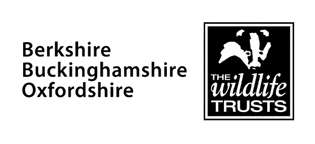 | |
| Conservation charity | |
| Headquarters |
The Lodge Armstrong Road Littlemore Oxford |
Area served | Berkshire, Buckinghamshire and Oxfordshire (United Kingdom) |
Key people |
|
|
| |
|
| |
| Total assets |
|
Number of employees |
|
| Website |
www |
The Berkshire, Buckinghamshire and Oxfordshire Wildlife Trust (BBOWT, pronounced /ˈbiːbaʊt/) is a wildlife trust covering the counties of Berkshire, Buckinghamshire and Oxfordshire in England.
The Trust was formerly called the Berkshire, Buckinghamshire and Oxfordshire Naturalists' Trust (BBONT).
Sites
Berkshire
Buckinghamshire
| Site | Photograph | Area[lower-alpha 1] | Location[lower-alpha 1] | Public access[lower-alpha 1] | Classifications | Description |
|---|---|---|---|---|---|---|
| Aston Clinton Ragpits[32] | 2.5 hectares (6.2 acres) | Aston Clinton 51°47′18″N 0°42′48″W / 51.7884°N 0.7132°W SP 888 107 |
YES | SSSI,[33] CAONB[34] | This grassland site has steeply sloping old pits and spoil heaps, with a rich assembly of shrubs, herbs and invertebrates, including twenty-seven butterfly species. There is some mature woodland with beech, yew, ash and whitebeam, together with a hedge and areas of scrub.[33] There are eight orchid species.[32] | |
| Bacombe Hill[35] |  |
25.0 hectares (62 acres) | Upper Bacombe 51°45′12″N 0°46′02″W / 51.7534°N 0.7671°W SP 864 074 |
YES | SSSI,[36] LNR,[37] CAONB[38] | The site is chalk grassland, scrub and woodland. It has pyramidal and bee orchids, wild thyme and chalkhill blue butterflies. The woodland on the slopes is mainly whitebeam and ash, with oak and birch on the plateau. Juniper shrubs provide a habitat for rare insects such as the juniper shield bug.[35] |
| Bernwood Meadows[39] |  |
7.5 hectares (19 acres) | Oakley 51°47′45″N 1°07′19″W / 51.7957°N 1.1220°W SP 606 111 |
YES | This traditional hay meadow has over 100 plant species, including lady's bedstraw, green winged orchids and cuckooflowers. It also has many species of butterfly, such as orange tip and rare black and brown hairstreaks. other wildlife includes brown hares, kestrels and moths.[39] | |
| Calvert Jubilee[40] |  |
22.0 hectares (54 acres) | Calvert 51°55′18″N 1°00′32″W / 51.9216°N 1.0090°W SP 682 252 |
YES | Most of the site is a deep lake, created by the extraction of clay for the brick industry. It is now used in winter by wildfowl such as mallard, tufted duck and pochard. There are two bird hides, and the trust has created three floating islands to enable waterfowl to breed safe from foxes. The lakeside has a variety of wild flowers and butterflies.[40] | |
| College Lake[41] | 65.0 hectares (161 acres) | Pitstone 51°49′12″N 0°39′00″W / 51.8201°N 0.6501°W SP 931 144 |
YES | SSSI[42][43] | The site has more than a thousand species of wildlife on the lake, marshland and grassland. Rare species include redshanks and Lapwings. The marshes are an important habitat for breeding waders, and chalk grassland has a range of insects and small mammals.[41] One small area is a geological Site of Special Scientific Interest.[42][43] | |
| Dancersend with Pavis Woods[44] | 85.0 hectares (210 acres) | Aston Clinton 51°46′35″N 0°41′46″W / 51.7765°N 0.6962°W SP 905 089 |
YES | SSSI,[45] CAONB[45] | There are woodland plantations, unimproved chalk grassland and scrub. The woods have few mature trees as most were felled during the 1940s, but a rich ground flora includes plants associated with ancient woodland, such as hairy brome and wood melick. The site is important for its butterflies and moths, and it has a diverse population of breeding birds.[45] | |
| Gomm Valley[46] | 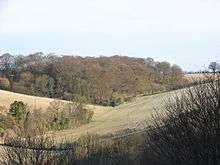 |
4.0 hectares (9.9 acres) | High Wycombe 51°37′17″N 0°42′21″W / 51.6215°N 0.7057°W SU 898 921 |
YES | SSSI,[47] CAONB,[48] | The site is chalk grassland which is reverting to scrub. It has a rich variety of herbs and of invertebrates, and is notable for reptiles and over-wintering birds, particularly thrushes. Over 30 species of butterflies and 180 of moths have been recorded.[47][46] |
| Grangelands and The Rifle Range[49] | 18.0 hectares (44 acres) | Cadsden 51°44′15″N 0°48′03″W / 51.7376°N 0.8009°W SP 828 050 |
YES | SSSI,[50] CAONB[50] | The site has grassland and scrub, which support interesting breeding birds and invertebrates, such as glow-worms and marbled white and chalk hill blue butterflies. There are areas of mature beech woodland, with a sparse shrub layer of holly and elder.[50] | |
| Hog and Hollowhill Woods[51] | 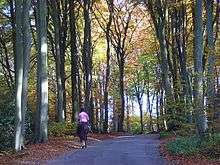 |
7.8 hectares (19 acres) | Marlow 51°52′54″N 0°59′07″W / 51.8818°N 0.9852°W SU 823 861 |
YES | SSSI,[51] SAC,[51] CAONB[51] | A large part of the site is mature beech woodland, the result of neglected coppicing. Much of the ground is bare, but there are some unusual plants, including the nationally rare ghost orchid. Trees on the lower slopes include ash, wild cherry and crab apple, and there is heather in more open areas.[52] |
| Homefield Wood[53] | 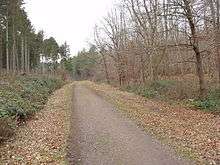 |
6.0 hectares (15 acres) | Hambleden 51°34′26″N 0°49′39″W / 51.5738°N 0.8275°W SU 814 867 |
YES | SSSI,[54] CAONB,[54] FC[54] | The site has young beech plantations, with some conifers and many native trees. There are rides and glades in some areas which have important and varied herb-rich chalk grassland, with plants such as Chiltern gentian and upright brome-grass and a variety of orchids. The rich invertebrate fauna includes thirty species of butterfly and over four hundred of moth.[54][53] |
| Little Linford Wood[55] | 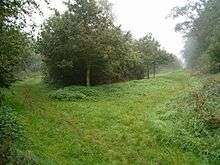 |
42.5 hectares (105 acres) | Little Linford 52°06′07″N 0°46′59″W / 52.1020°N 0.7831°W SP 834 455 |
YES | Much of the woodland is young as it was felled in 1980, shortly before the Trust took over the site, but there are also areas of mature oak and ash. In 1998 dormice were introduced, and they live high up in the canopy. Other mammals include stoats and badgers, and there are birds such as great spotted woodpeckers, kestrels and buzzards. Grassy rides provide a habitat for butterflies.[55] | |
| Long Grove Wood[56] | 1.5 hectares (3.7 acres) | Seer Green 51°36′55″N 0°36′35″W / 51.6154°N 0.6098°W SU 963 916 |
YES | The site is deciduous woodland with the main trees being beach and hornbeam. The Great Storm of 1987 brought down several trees, creating open areas which were colonised by flowers such as bluebell and yellow archangel. Dead wood is kept to provide a habitat for insects and fungi. Birds include great spotted woodpeckers and tree creepers.[56] | ||
| Millfield Wood[57] | 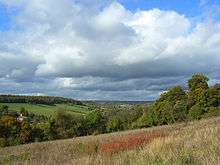 |
7.5 hectares (19 acres) | High Wycombe 51°39′04″N 0°44′36″W / 51.6511°N 0.7432°W SU 870 956 |
YES | SSSI[58] | The site was owned in the late nineteenth century by Benjamin Disraeli, and the woodland is much older. It is semi-natural beech woodland on chalk, which is an unusual habitat, and it also has considerable wych elm. Its rich ground flora includes many wild flowers. There are a number of badger setts and a varied invertebrate fauna. Birds include great spotted woodpeckers and chiffchaffs.[58][57] |
| Pilch Field[59] |  |
12.0 hectares (30 acres) | Great Horwood 51°59′01″N 0°54′47″W / 51.9837°N 0.9130°W SP 749 321 |
YES | SSSI[60] | The site has two fields called Big Pilch and Little Pilch. The varied habitats in Big Pilch include wetland, fen, scrub, a stream and ridge-and-furrow grassland. The stream continues into Little Pilch, which has spring-fed fen and grassland. Over two hundred flowering plants have been recorded.[61] There are birds such as turtle doves, yellowhammers and reed buntings.[59] |
| Rushbeds Wood[62] | 56.0 hectares (138 acres) | Wotton Underwood 51°50′01″N 1°01′26″W / 51.8336°N 1.0240°W SP 673 154 |
YES | SSSI[63] | The site is ancient woodland on heavy clay soils which are often waterlogged. The invertebrate fauna are described by Natural England as "exceptional", including over thirty butterfly species, such as the nationally rare black hairstreak and the scarce wood white and purple emperor. The woodland is wet ash and maple, and the understorey has species indicative of long tree cover, such as Poa nemoralis. In the ponds and ditches there are breeding smooth and great crested newts.[63] | |
| Upper Ray Meadows[64] | 181.0 hectares (447 acres) | Marsh Gibbon 51°52′30″N 1°01′44″W / 51.8750°N 1.0289°W SP 669 200 |
PP | SSSI[65] | The site consists of meadows on the floodplain of the River Ray, and it is a stronghold for rare species because heavy clay soils and frequent flooding makes arable farming difficult. Medieval ridge and furrow can still be seen in some fields. In the summer, drier areas have displays of wild flowers such as black knapweed, meadowsweet and tufted vetch.[64] | |
| Weston Turville Reservoir[66] |  |
18.5 hectares (46 acres) | Weston Turville 51°46′44″N 0°45′04″W / 51.7789°N 0.7512°W SP 862 096 |
YES | SSSI,[67] CAONB[68] | The reservoir was built in 1797 to supply water to the Wendover Arm of the Grand Union Canal.[66][68] Large areas have a deep silt deposit, but the open water is an important site for 46 species of over-wintering waterfowl, and it is nationally important for shovelers. The areas around the reservoir has tall fen, reed beds and willow carr, which are declining habitats in Britain. There are over 300 species of beetle, of which six are rare nationally.[67] |
| Yoesden[69] | 13.8 hectares (34 acres) | Bledlow Ridge 51°40′29″N 0°51′35″W / 51.6748°N 0.8596°W SU 789 979 |
YES | The site has areas of woodland and grassland. The steeply sloping chalk meadow has many species of butterfly, including three scarce blue species, the Adonis, chalkhill and small blue. There are flowers such as common spotted and fragrant orchids. Beech woodland above the chalk bank supports great spotted woodpeckers and great spotted woodpeckers, and lower woodland has beech and yews.[69] | ||
Oxfordshire
Notes
References
- ↑ "Who We Are—People". BBOWT. Retrieved 26 August 2014.
- 1 2 3 4 "Report and Financial Statements (2012)" (PDF). BBOWT. Retrieved 26 August 2014.
- ↑ "Who We Are". BBOWT. Retrieved 26 August 2014.
- ↑ "Audrey's Meadow". Berkshire, Buckinghamshire and Oxfordshire Wildlife Trust. Retrieved 17 February 2016.
- ↑ "Avery's Pightle". Berkshire, Buckinghamshire and Oxfordshire Wildlife Trust. Retrieved 17 February 2016.
- ↑ "Bowdown Woods". Berkshire, Buckinghamshire and Oxfordshire Wildlife Trust. Retrieved 17 February 2016.
- ↑ "Bray Pit". Berkshire, Buckinghamshire and Oxfordshire Wildlife Trust. Retrieved 17 February 2016.
- ↑ "Bucklebury Common". Berkshire, Buckinghamshire and Oxfordshire Wildlife Trust. Retrieved 17 February 2016.
- ↑ "Chawridge Bank". Berkshire, Buckinghamshire and Oxfordshire Wildlife Trust. Retrieved 17 February 2016.
- ↑ "Decoy Heath". Berkshire, Buckinghamshire and Oxfordshire Wildlife Trust. Retrieved 17 February 2016.
- ↑ "Finemere Wood". Berkshire, Buckinghamshire and Oxfordshire Wildlife Trust. Retrieved 17 February 2016.
- ↑ "Greenham and Crookham Commons". Berkshire, Buckinghamshire and Oxfordshire Wildlife Trust. Retrieved 17 February 2016.
- ↑ "Haymill Valley". Berkshire, Buckinghamshire and Oxfordshire Wildlife Trust. Retrieved 17 February 2016.
- ↑ "Hosehill Lake". Berkshire, Buckinghamshire and Oxfordshire Wildlife Trust. Retrieved 17 February 2016.
- ↑ "Inkpen Common". Berkshire, Buckinghamshire and Oxfordshire Wildlife Trust. Retrieved 17 February 2016.
- ↑ "Inkpen Crocus Field". Berkshire, Buckinghamshire and Oxfordshire Wildlife Trust. Retrieved 17 February 2016.
- ↑ "Kintbury Newt Ponds". Berkshire, Buckinghamshire and Oxfordshire Wildlife Trust. Retrieved 17 February 2016.
- ↑ "Loddon Nature Reserve". Berkshire, Buckinghamshire and Oxfordshire Wildlife Trust. Retrieved 17 February 2016.
- ↑ "Moor Copse". Berkshire, Buckinghamshire and Oxfordshire Wildlife Trust. Retrieved 17 February 2016.
- ↑ "Nature Discovery Centre". Berkshire, Buckinghamshire and Oxfordshire Wildlife Trust. Retrieved 17 February 2016.
- ↑ "Padworth Common". Berkshire, Buckinghamshire and Oxfordshire Wildlife Trust. Retrieved 17 February 2016.
- ↑ "Paices Wood Country Parkland". Berkshire, Buckinghamshire and Oxfordshire Wildlife Trust. Retrieved 17 February 2016.
- ↑ "Rack Marsh". Berkshire, Buckinghamshire and Oxfordshire Wildlife Trust. Retrieved 17 February 2016.
- ↑ "Seven Barrows". Berkshire, Buckinghamshire and Oxfordshire Wildlife Trust. Retrieved 17 February 2016.
- ↑ "Shepperlands Farm". Berkshire, Buckinghamshire and Oxfordshire Wildlife Trust. Retrieved 17 February 2016.
- ↑ "Snelsmore Common Country Park". Berkshire, Buckinghamshire and Oxfordshire Wildlife Trust. Retrieved 17 February 2016.
- ↑ "Sole Common Pond". Berkshire, Buckinghamshire and Oxfordshire Wildlife Trust. Retrieved 17 February 2016.
- ↑ "Thatcham Reedbeds". Berkshire, Buckinghamshire and Oxfordshire Wildlife Trust. Retrieved 17 February 2016.
- ↑ "Watts Bank". Berkshire, Buckinghamshire and Oxfordshire Wildlife Trust. Retrieved 17 February 2016.
- ↑ "Wildmoor Heath". Berkshire, Buckinghamshire and Oxfordshire Wildlife Trust. Retrieved 17 February 2016.
- ↑ "Wokefield Common". Berkshire, Buckinghamshire and Oxfordshire Wildlife Trust. Retrieved 17 February 2016.
- 1 2 "Aston Clinton Ragpits". Berkshire, Buckinghamshire and Oxfordshire Wildlife Trust. Retrieved 9 October 2015.
- 1 2 "Aston Clinton Ragpits citation" (PDF). Sites of Special Scientific Interest. Natural England. Archived from the original (PDF) on 10 April 2016. Retrieved 9 October 2015.
- ↑ "Aston Clinton Ragpits". Chilterns Conservation Board. Retrieved 9 October 2015.
- 1 2 "Bacombe Hill". Berkshire, Buckinghamshire and Oxfordshire Wildlife Trust. Retrieved 15 February 2016.
- ↑ "Bacombe and Coombe Hills citation" (PDF). Sites of Special Scientific Interest. Natural England. Archived from the original (PDF) on 31 December 2014. Retrieved 4 January 2015.
- ↑ "Bacombe Hill". Local Nature Reserves. Natural England. 8 August 2013. Archived from the original on 4 January 2015. Retrieved 4 January 2015.
- ↑ "Bacombe Hill Local Nature Reserve". Chilterns Conservation Board. Retrieved 4 January 2015.
- 1 2 "Bernwood Meadows". Berkshire, Buckinghamshire and Oxfordshire Wildlife Trust. Retrieved 15 February 2016.
- 1 2 "Calvert Jubilee". Berkshire, Buckinghamshire and Oxfordshire Wildlife Trust. Retrieved 15 February 2016.
- 1 2 "College Lake". Berkshire, Buckinghamshire and Oxfordshire Wildlife Trust. Retrieved 15 February 2016.
- 1 2 "Pitstone Quarry citation" (PDF). Sites of Special Scientific Interest. Natural England. Archived from the original (PDF) on 4 March 2016. Retrieved 9 October 2015.
- 1 2 "Map of Pitstone Quarry". Sites of Special Scientific Interest. Natural England. Retrieved 9 October 2015.
- ↑ "Dancersend with Pavis Woods". Berkshire, Buckinghamshire and Oxfordshire Wildlife Trust. Retrieved 15 February 2016.
- 1 2 3 "Dancersend with Pavis Woods citation" (PDF). Sites of Special Scientific Interest. Natural England. Archived from the original (PDF) on 24 January 2016. Retrieved 10 October 2015.
- 1 2 "Gomm Valley". Berkshire, Buckinghamshire and Oxfordshire Wildlife Trust. Retrieved 9 January 2015.
- 1 2 "Gomm Valley citation" (PDF). Sites of Special Scientific Interest. Natural England. Archived from the original (PDF) on 4 March 2016. Retrieved 9 January 2015.
- ↑ "Gomm Valley". Chilterns Conservation Board. Retrieved 9 January 2015.
- ↑ "Grangelands and The Rifle Range". Berkshire, Buckinghamshire and Oxfordshire Wildlife Trust. Retrieved 15 February 2016.
- 1 2 3 "Grangelands and Pulpit Hill citation" (PDF). Sites of Special Scientific Interest. Natural England. Archived from the original (PDF) on 31 December 2014. Retrieved 10 January 2015.
- 1 2 3 4 "Hog and Hollowhill Woods". Berkshire, Buckinghamshire and Oxfordshire Wildlife Trust. Retrieved 15 February 2016.
- ↑ "Pullingshill and Hollowhill Woods citation" (PDF). Sites of Special Scientific Interest. Natural England. Archived from the original (PDF) on 4 March 2016. Retrieved 28 September 2015.
- 1 2 "Homefield Wood". Berkshire, Buckinghamshire and Oxfordshire Wildlife Trust. Retrieved 15 February 2016.
- 1 2 3 4 "Homefield Wood citation" (PDF). Sites of Special Scientific Interest. Natural England. Archived from the original (PDF) on 1 October 2015. Retrieved 29 September 2015.
- 1 2 "Little Linford Wood". Berkshire, Buckinghamshire and Oxfordshire Wildlife Trust. Retrieved 15 February 2016.
- 1 2 "Long Grove Wood". Berkshire, Buckinghamshire and Oxfordshire Wildlife Trust. Retrieved 15 February 2016.
- 1 2 "Millfield Wood". Berkshire, Buckinghamshire and Oxfordshire Wildlife Trust. Retrieved 15 February 2016.
- 1 2 "Millfield Wood citation" (PDF). Sites of Special Scientific Interest. Natural England. Archived from the original (PDF) on 25 January 2016. Retrieved 11 October 2015.
- 1 2 "Pilch Field". Berkshire, Buckinghamshire and Oxfordshire Wildlife Trust. Retrieved 15 February 2016.
- ↑ "Pilch Fields citation" (PDF). Sites of Special Scientific Interest. Natural England. Archived from the original (PDF) on 4 March 2016. Retrieved 12 October 2015.
- ↑ "Pilch Fields". Milton Keynes Natural History Society. Retrieved 12 October 2015.
- ↑ "Rushbeds Wood". Berkshire, Buckinghamshire and Oxfordshire Wildlife Trust. Retrieved 15 February 2016.
- 1 2 "Rushbeds Wood and Railway Cutting citation" (PDF). Sites of Special Scientific Interest. Natural England. Archived from the original (PDF) on 4 March 2016. Retrieved 7 April 2016.
- 1 2 "Upper Ray Meadows". Berkshire, Buckinghamshire and Oxfordshire Wildlife Trust. Retrieved 15 February 2016.
- ↑ "Long Herdon Meadow citation" (PDF). Sites of Special Scientific Interest. Natural England. Archived from the original (PDF) on 4 March 2016. Retrieved 20 March 2016.
- 1 2 "Weston Turville Reservoir". Berkshire, Buckinghamshire and Oxfordshire Wildlife Trust. Retrieved 15 February 2016.
- 1 2 "Weston Turville Reservoir citation" (PDF). Sites of Special Scientific Interest. Natural England. Retrieved 13 October 2015.
- 1 2 "Weston Turville Reservoir". Chilterns Conservation Board. Retrieved 13 October 2015.
- 1 2 "Yoesden". Berkshire, Buckinghamshire and Oxfordshire Wildlife Trust. Retrieved 15 February 2016.
- ↑ "Ardley Wood Quarry". Berkshire, Buckinghamshire and Oxfordshire Wildlife Trust. Retrieved 18 February 2016.
- ↑ "Asham Meads". Berkshire, Buckinghamshire and Oxfordshire Wildlife Trust. Retrieved 6 May 2016.
- ↑ "Blenheim Farm". Berkshire, Buckinghamshire and Oxfordshire Wildlife Trust. Retrieved 18 February 2016.
- ↑ "Chimney Meadows". Berkshire, Buckinghamshire and Oxfordshire Wildlife Trust. Retrieved 18 February 2016.
- ↑ "Chinnor Hill". Berkshire, Buckinghamshire and Oxfordshire Wildlife Trust. Retrieved 18 February 2016.
- ↑ "Cholsey Marsh". Berkshire, Buckinghamshire and Oxfordshire Wildlife Trust. Retrieved 18 February 2016.
- ↑ "CS Lewis Nature Reserve". Berkshire, Buckinghamshire and Oxfordshire Wildlife Trust. Retrieved 18 February 2016.
- ↑ "Dry Sandford Pit". Berkshire, Buckinghamshire and Oxfordshire Wildlife Trust. Retrieved 18 February 2016.
- ↑ "Foxholes". Berkshire, Buckinghamshire and Oxfordshire Wildlife Trust. Retrieved 18 February 2016.
- ↑ "Glyme Valley". Berkshire, Buckinghamshire and Oxfordshire Wildlife Trust. Retrieved 18 February 2016.
- ↑ "Hartslock". Berkshire, Buckinghamshire and Oxfordshire Wildlife Trust. Retrieved 18 February 2016.
- ↑ "Hitchcopse Pit". Berkshire, Buckinghamshire and Oxfordshire Wildlife Trust. Retrieved 18 February 2016.
- ↑ "Hook Norton Cutting". Berkshire, Buckinghamshire and Oxfordshire Wildlife Trust. Retrieved 18 February 2016.
- ↑ "Hurley Chalk Pit". Berkshire, Buckinghamshire and Oxfordshire Wildlife Trust. Retrieved 18 February 2016.
- ↑ "Iffley Meadows". Berkshire, Buckinghamshire and Oxfordshire Wildlife Trust. Retrieved 18 February 2016.
- ↑ "Lamb's Pool". Berkshire, Buckinghamshire and Oxfordshire Wildlife Trust. Retrieved 18 February 2016.
- ↑ "Lashford Lane Fen". Berkshire, Buckinghamshire and Oxfordshire Wildlife Trust. Retrieved 18 February 2016.
- ↑ "Letcombe Valley". Berkshire, Buckinghamshire and Oxfordshire Wildlife Trust. Retrieved 18 February 2016.
- ↑ "Oakley Hill". Berkshire, Buckinghamshire and Oxfordshire Wildlife Trust. Retrieved 18 February 2016.
- ↑ "Oxey Mead". Berkshire, Buckinghamshire and Oxfordshire Wildlife Trust. Retrieved 18 February 2016.
- ↑ "Parsonage Moor". Berkshire, Buckinghamshire and Oxfordshire Wildlife Trust. Retrieved 18 February 2016.
- ↑ "Sydlings Copse". Berkshire, Buckinghamshire and Oxfordshire Wildlife Trust. Retrieved 18 February 2016.
- ↑ "Tuckmill Meadow". Berkshire, Buckinghamshire and Oxfordshire Wildlife Trust. Retrieved 18 February 2016.
- ↑ "Warburg Nature Reserve". Berkshire, Buckinghamshire and Oxfordshire Wildlife Trust. Retrieved 18 February 2016.
- ↑ "Warren Bank". Berkshire, Buckinghamshire and Oxfordshire Wildlife Trust. Retrieved 18 February 2016.
- ↑ "Wells Farm". Berkshire, Buckinghamshire and Oxfordshire Wildlife Trust. Retrieved 18 February 2016.
- ↑ "Westwell Gorse". Berkshire, Buckinghamshire and Oxfordshire Wildlife Trust. Retrieved 18 February 2016.
- ↑ "Whitecross Green Wood". Berkshire, Buckinghamshire and Oxfordshire Wildlife Trust. Retrieved 15 February 2016.
External links
This article is issued from
Wikipedia.
The text is licensed under Creative Commons - Attribution - Sharealike.
Additional terms may apply for the media files.






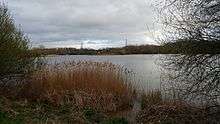

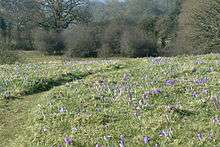










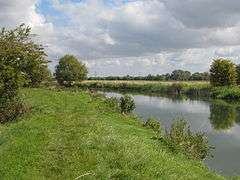


_male_eating_insect.jpg)






